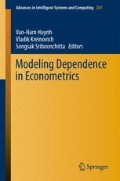Abstract
Geometric Process (GP) model is proposed as an alternative model for financial time series. The model contains two components: the mean of an underlying renewal process and the ratio which measures the direction and strength of the dynamic trend pattern over time. They simultaneously account for the uncertainty on the mean and the autoregressive and time-varying nature of the volatility. Compare to the popular GARCH and SV models, this model is simple and easy to implement using the least squares (LS) method.We extend the GP model to analyze the daily asset price range which exhibit threshold and asymmetric effects for some exogenous variables. Models are selected according to mean square error (MSE). Finally forecasting are performed for the best model that allows for both threshold and asymmetric effects.
Access this chapter
Tax calculation will be finalised at checkout
Purchases are for personal use only
Preview
Unable to display preview. Download preview PDF.
References
Andersen, T., Bollerslev, T.: Answering the skeptics: yes, standard volatility models do provide accurate forecasts. International Economic Review 39, 885–905 (1998)
Bollerslev, T.: Generalized autoregressive conidtional heteroskedasticity. Journal of Econometrics 31, 307–327 (1986)
Brandt, M.W., Jones, C.S.: Volatility forecasting with range-based EGARCH models. Journal of Business and Economic Statistics 24, 470–486 (2006)
Chan, J.S.K., Lam, Y., Leung, D.Y.P.: Statistical inference for geometric processes with gamma distributions. Computional Statistics and Data Analysis 47, 565–581 (2004)
Chan, J.S.K., Yu, P.L.H., Lam, Y., Ho, A.P.K.: Modeling SARS data using threshold geometric process. Statistics in Medicine 25, 1826–1839 (2006)
Chan, J.S.K., Leung, D.Y.P.: A new approach to the modelling longitudinal binary data with trend: the binary geometric process model. Computational Statistics 25, 505–536 (2010)
Chan, J.S.K., Lam, C.P.Y., Yu, P.L.H., Choy, S.T.B., Chen, C.W.S.: A Bayesian conditional autoregressive geometric process model for range data. Computational Statistics and Data Analysis 56, 3006–3019 (2012)
Chen, C.W.S., Gerlach, R.H., Lin, E.M.H.: Forecast volatility from threshold heteroskedastic range models. Computational Statistics and Data Analysis, on Statistical & Computational Methods in Finance 52, 2990–3010 (2008)
Chou, R.: Forecasting Financial Volatilities With Extreme Values: The Conditional Autoregressive Range (CARR) Model. Journal of Money Credit and Banking 37, 561–582 (2005)
Engle, R.F.: Autoregressive conditional heteroscedasticity with estimates of the variance of United Kingdom inflation. Econometrica 50, 987–1008 (1982)
Feller, W.: Fluctuation theory of recurrent events. Transactions of the American Mathematical Society 67, 98–119 (1949)
Garman, M.B., Klass, M.J.: On the estimation of price volatility from historical data. Journal of Business 53, 67–78 (1980)
Gilks, W.R., Richardson, S., Spiegelhalter, D.J.: Markov Chain Monte Carlo in Practice. Chapman and Hall, UK (1996)
Heston, S.L.: A closed-form solution for options with stochastic volatility with applications to bond and currency options. Review of Financial Studies 6, 327–343 (1993)
Hull, J.C., White, A.: An analysis of the bias in option pricing caused by by a stochastic volatility. Advances in Futures and Options Research 3, 29–61 (1988)
Lam, Y.: Geometric process and replacement problem. Acta Mathematicae Applicatae Sinica 4, 366–377 (1988)
Lam, Y.: Nonparametric inference for geometric processes. Commun. Statist. Theory Meth. 21, 2083–2105 (1992)
Lam, Y., Chan, J.S.K.: Statistical inference for geometric processes with lognormal distribution. Computional Statistics and Data Analysis 27, 99–112 (1998)
Lam, Y.: The Geometric Process and it’s applications. World Scientific Publishing Co. Pte. Ltd. (2007)
Parkinson, M.: The extreme value method for estimating the variance of the rate of return. Journal of Business 53, 61–65 (1980)
Smith, A.F.M., Roberts, G.O.: Bayesian Computation via the Gibbs Sampler and Related Markov Chain Monte Carlo Methods. Journal of the Royal Statistical Society B 55, 3–23 (1993)
Spiegelhalter, D., Thomas, A., Best, N.: Bayesian inference using Gibbs sampling for Window version (2000), The website for WinBUGS is http://www.mrc-bsu.cam.ac/bugs
Spiegelhalter, D., Best, N.G., Carlin, B.P., Van der Linde, A.: Bayesian Measures of Model Complexity and Fit (with Discussion). Journal of the Royal Statistical Society B 64, 583–616 (2002)
Wan, W.Y., Chan, J.S.K.: A new approach for handling longitudinal count data with zero inflation and overdispersion: Poisson Geometric Process model. Biometrical Journal 51, 556–570 (2009)
Wan, W.Y., Chan, J.S.K.: Bayesian analysis of robust Poisson geometric process model using heavy-tailed distributions. Computational Statistics and Data Analysis 55, 687–702 (2011)
Author information
Authors and Affiliations
Corresponding author
Editor information
Editors and Affiliations
Rights and permissions
Copyright information
© 2014 Springer International Publishing Switzerland
About this paper
Cite this paper
Chan, J.S.K., Lam, C.P.Y., Choy, S.T.B. (2014). An Innovative Financial Time Series Model: The Geometric Process Model. In: Huynh, VN., Kreinovich, V., Sriboonchitta, S. (eds) Modeling Dependence in Econometrics. Advances in Intelligent Systems and Computing, vol 251. Springer, Cham. https://doi.org/10.1007/978-3-319-03395-2_5
Download citation
DOI: https://doi.org/10.1007/978-3-319-03395-2_5
Publisher Name: Springer, Cham
Print ISBN: 978-3-319-03394-5
Online ISBN: 978-3-319-03395-2
eBook Packages: EngineeringEngineering (R0)

